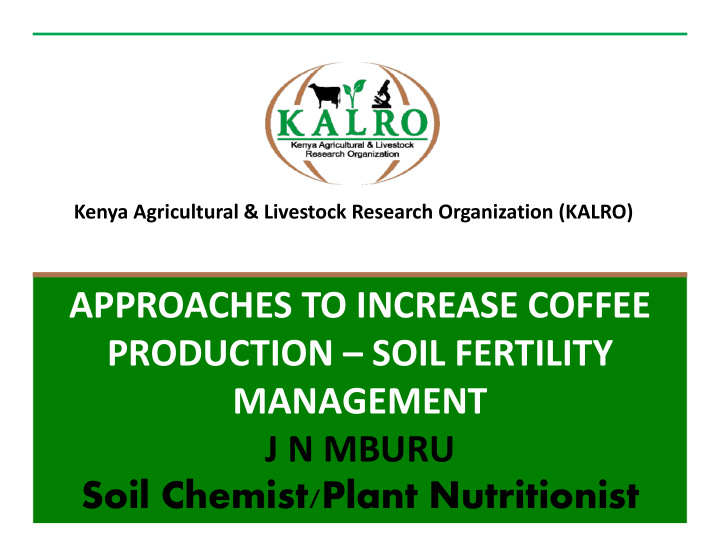



Kenya Agricultural & Livestock Research Organization (KALRO) APPROACHES TO INCREASE COFFEE PRODUCTION – SOIL FERTILITY MANAGEMENT J N MBURU Soil Chemist/Plant Nutritionist
Transition from a high yielding coffee before 1990s through the current productivity of below 3kg per tree Before mid 1980s After coffee liberalization – 1990s Current Situation
KEY APPROACHES TOWARDS IMPROVING COFFEE NUTRITION Soil sampling and mapping • Soil and leaf analysis service for 45 years provided to coffee growers by CRI • GPS aided Soil sampling for fertility mapping by agro zones within counties • Nutrient deficit corrective measures at agro zone and county levels • Appropriate fertilizer formulations for the specific agro zones at macro ‐ level regions • Periodic 3 ‐ 4 year monitoring, referencing to the original sample points • Addressing need for soil amelioration/conditioning in the mapped areas • Training farmers in identifying fertilizers for food crops and for coffee
Case Case st study of of co county soil soil Fertility rtility ma manage nageme ment guide guide • GPS aided soil fertility mapping has been in progress aiming to cover all 32 coffee growing counties and establish plant nutrient deficits that are partly responsible for the declined coffee production. • The results are expected to yield region specific fertilizer recommendations at farmer, agrozone and county/region levels. • Equally, the results may find use in reformulating region specific fertilizers fully addressing the identified deficits. • The 7 counties covered include Meru, Embu, Machakos, Makueni, Uasin Gishu/Elgeyo Marakwet, Bungoma and West Pokot.
Embu Embu Coun County ty Fig 6: Available Phosphorus (P) deficit correction Fig 5: Nutrient deficit correction gap, me% gap, ppm for Embu including soil reaction and exchangeable acidity for Embu. In summary, the results show that Phosphorus is deficient in all agrozones but more acutely in UM2 followed by UM1.
Ma Machakos County Fig 7: Nutrient deficit correction gap, me% including Fig 8: Available Phosphorus (P) deficit correction soil reaction and exchangeable acidity for Machakos gap, ppm for Machakos In Machakos County, the available phosphorus correction gap increases with agrozone and this is an indication of increasing coffee productivity potential with agrozone
Ke Keiyo and and Ma Marakwet et sub co counties Fig 9: Nutrient deficit correction gap, me% Fig 10: Available Phosphorus (P) deficit including soil reaction and exchangeable acidity correction gap, ppm for Elgeyo Marakwet for Elgeyo Marakwet Phosphorous was found excessively available in Marakwet West, East and Keiyo North sub counties. This could have been attributed to the observed rampant use of DAP in this maize growing region where many times the crop was found interplanted with coffee
UA UASIN GI GISHU SHU CO COUNTY Fig 11: Nutrient deficit correction gap, me% including soil Fig 12: Available Phosphorus (P) deficit correction gap, ppm for reaction and exchangeable acidity for Uasin Gishu Uasin Gishu Like Elgeyo Marakwet, soil acidity and Manganese were found within the sufficiency zone in the sub counties of Kesses, Turbo and Eldoret West while Potassium showed notable deficit in the 3 counties. Magnesium was slightly in excess in all the 3 counties while Calcium was highly excessive Phosphorus was excessively supplied in Kesses and Eldoret West sub counties and moderately excessive in Turbo sub county.
Plant friendly soil living organisms • Micro organisms ‐ aided nutrient extraction by plant roots like Mycorrhizae and rhizobium (N fixer) • Raising population of the micro flora by fresh introduction of organic matter • Utilization of soil mycorrhizae under farmer practice
Yield improvement through introduction of micro flora Fig 3: Under full Farmer Practice (Kitale) – Fig 4: Under Partial Farmer Practice (Kitale) Manure included – Manure excluded
Root oot Enhancing Enhancing mi micro flor flora rich rich hum humus us • Rooting enhancement by mycorrhizae seeded in a humus enriched potting menu. Plate 2: Mycorrhizae and Mizizi humus (+) Plate 3: STD Potting Mixture
Plate 5: Shoot growth Plate 4: Root Mass
At establishment stage. 11 month old raised by enriched establishment menu Plate 7: Advanced Cropping – 13 months Plate 6:11 month old ‐ rapid from planting growth
Use of agro forestry in coffee farming system Plate 8: Shaded coffee plot .Source: Komothai Small Holder Farmer – J.M.Muhia Various woody tree species have potential for soil fertility enhancement. Important to consider tree species that would be properly managed for green manure, firewood, poles, fodder, bee forage, shade, nitrogen fixation, herbal remedies and nutrition in form of edible fruits and vegetables.
If genetically diversified families can feed on the same plate, WHY NOT KENYANS? HAVE A GOOD DAY.
Recommend
More recommend